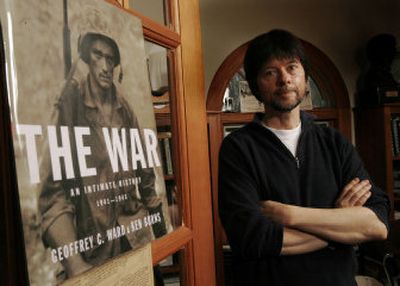WWII documentary takes toll on Burns

There are downsides to making important documentaries, and one of them is the nightmares.
Ken Burns and his filmmaking crew spent more than two years editing hundreds of hours of interviews, thousands of hours of film, and tens of thousands of still photos to make the nearly 15-hour documentary “The War,” which premieres Sunday on PBS. That alone can wear on someone.
But these were films from battle and stories of war and brutality and suffering, and for Burns and his editors, it became haunting.
“We’d be working on (the battle of) Peleliu,” Burns says. “In the middle of the night, I’d be dreaming about being in the editing room, then I’d be in the battle. The next day, the editor would be hollow-eyed, too, and we’d both go, ‘Peleliu.’ “
He understands the much larger psychic toll World War II took on the millions of people who fought it, and that the film will evoke those nightmarish thoughts for many viewers.
“You’re listening to the ghosts and echoes from an almost inexpressible past,” Burns says. “If you do that, you put yourself into the emotional maelstrom.”
At age 54, Burns has spent his life diving into the emotional maelstroms of history, in his epic films like “Jazz” and “Baseball” and “The Civil War,” and in shorter works ranging from the Academy Award-nominated “Brooklyn Bridge” to “Mark Twain.”
With “The War,” he attempts to get to the core truth of not just the battles of the second world war, but also to its reverberations across the planet and across the years.
But there is another, equally heartbreaking truth that is woven through the film: America has almost forgotten the horror of World War II.
“It is the greatest cataclysm in human history,” Burns says. “But we’ve lost sight of that.
“This has become ‘the good war.’ We draped it in such bloodless, gallant myth that its lessons are smothered in our attempt to sanitize it and make serviceable a kind of treacly, morning-in-America notion.
“We can’t do this. This was not a good war. There is no such thing as a good war. This was, in fact, the worst war ever. I think the forgetting happened for some pretty understandable and forgivable reasons, even though the manifestations of that are so unforgivable.”
First among those manifestations has been a neglect of the people who fought that war. Attention is beginning to be paid in recent movies, like “Saving Private Ryan,” “Band of Brothers” and “Letters From Iwo Jima,” and in books like Tom Brokaw’s “The Greatest Generation.”
But it comes so late, Burns argues, and there is still so much to be said.
“We took teenagers and turned them into professional killers, and they become very good at it. They needed to be to survive,” he says.
“Then they came back, and we said, ‘OK, don’t be killers again.’ And there was such a discomfort on the part of the rest of us, asking them to go, that we really didn’t want to hear about it.
“The sense that your death is imminent – and they had that constantly, every moment – it alters your whole consciousness. But when they came back, there was no place for them to put this stuff. No way they could describe it to the rest of us, and we didn’t want them to.”
“The War” follows World War II through the soldiers and the people of four American cities: Luverne, Minn.; Mobile, Ala.; Waterbury, Conn., and Sacramento, Calif. Yet those people are still just parts of a larger, complicated whole.
The film’s length carefully and powerfully builds both an intellectual and a visceral awareness of the misery and the tragedy of the war. By its end, it has plunged viewers into that emotional maelstrom.
Burns’ filmmaking techniques also add to the effect. He makes still photos come alive with slow pans across the picture, or by zooming the focus in and out. The effect is strong, but subtle enough that viewers aren’t taken out of the moment.
The arbitrariness of death is a theme Burns builds carefully through the film.
“There’s the line, ‘You can’t be careful, you can only be lucky,’ ” he says. “This is the reality of war. This is what war is about.
“It’s not about the heroism in old movies, it’s an even more impressive heroism. It’s the real, day-in, day-out calculus of total randomness.
“The flak hits your wing and you live. It hits your neighbor’s fuel tank and he’s gone. What decides that? Chance. It’s just luck.”
When he talks for long about the film and about the war, Burns returns often to the men who fought and who sat to talk about their experiences and their lives.
One man in particular, Quentin Aanenson, a fighter pilot from Luverne, seems to have found a soft spot with Burns, as he will with many viewers.
Aanenson is a gentle, decent man who is still, deep down, horrified about the people he killed, though he never questions the necessity.
Six decades later, maybe riding a tractor, maybe sitting in his kitchen, he will still flash back to the war, to the adrenaline and fear and instinctive reactions. Watching the film, your heart aches to hear his stories.
“You can see it in every twitch on his face, in every gulp and every blink,” Burns says. “He still gets pulled back into that world. And he is only beginning to be able to talk about it.
“There are millions of men like Quentin, and we’re losing them to age. Now is the time. It is incumbent on us, especially at the end of their lives, to listen to what they have to say.”